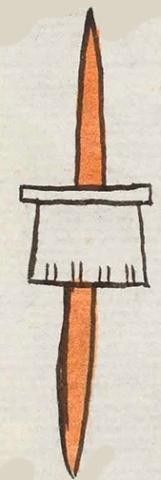Huitzoco (Mdz37r)
This simplex glyph for the digging stick (huitzoctli) doubles for the place name Huitzoco. The -co locative suffix is not represented visually. This representation of an agricultural planting stick is shown standing vertically. The orange color gives the impression of wood, probably hardwood (e.g. oak). In the middle of the stick appears a white, rectangular element, possibly held on with a tie or hanging from a crossbar. Small vertical lines appear along the bottom edge of the rectangle of what may be paper.
Stephanie Wood
If this is not a digging stick for agricultural uses, it may be a pointed war club. Notice how the white rectangle in the middle of the stick has a resemblance to some of the examples of quemitl from various other glyphs; this was apparently a bib that could be warn over a person's face or chest. The association may give the huitzoctli a possible ritual dimension. Huitzoctli digging sticks are mentioned in a seventeenth-century testament as being brought out to break soil in a field when this action had a religious significance. [See: James Lockhart, The Nahuas (1992), p. 201.] The huitz- part of the term may have a connection to huitztli, thorn or spine. The huictli was a similar instrument, and both a pre-contact huitzoctli and a huictli are on display in the museum of the Templo Mayor in Mexico City. Wikipedia offers additional examples, many from manuscripts. The one from the Historia Tolteca-Chichimeca has a handle resembling a serpent head. After contact, a synonym for huictli was coa, not actually related to coatl (serpent, snake), because it was a term imported to Mexico from the Caribbean, according to James Lockhart, The Nahuas (1992), 531, note 281. Mexicolore also has a short study of the huictli. Many huictli tools were shaped like a very large thorn (huitztli), with a flat blade in the lower part.
Stephanie Wood
huitzoco.puo
Huitzoco, pueblo
Stephanie Wood
c. 1541, but by 1553 at the latest
Stephanie Wood
digging sticks, tools, agriculture, coas, palos para agricultura, herramientas, coas, nombres de lugares

huitzoc(tli), digging stick, agricultural implement, https://nahuatl.wired-humanities.org/content/huitzoctli
-co (locative suffix), in or at, https://nahuatl.wired-humanities.org/content/co
"Digging Stick Place" [Frances Karttunen, unpublished manuscript, used here with her permission.]
"On the Digging Stick" (Berdan and Anawalt, 1992, vol. 1, p. 189)
"El Lugar del Palo de Excavación"
Stephanie Wood
Codex Mendoza, folio 37 recto, https://digital.bodleian.ox.ac.uk/objects/2fea788e-2aa2-4f08-b6d9-648c00..., image 84 of 188.
Original manuscript is held by the Bodleian Libraries, University of Oxford, MS. Arch. Selden. A. 1; used here with the UK Creative Commons, “Attribution-NonCommercial-ShareAlike 3.0 License” (CC-BY-NC-SA 3.0)



